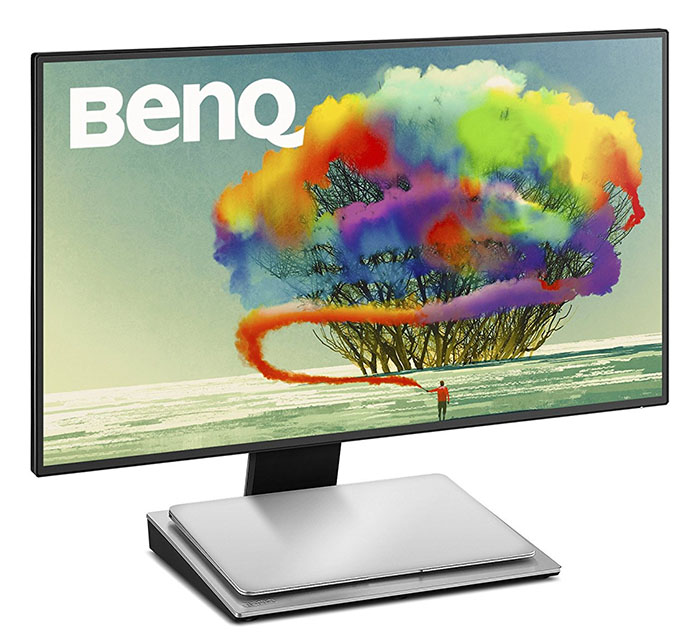Early Verdict
It seems that 27” is the sweet spot among desktop monitor sizes. And QHD resolution provides ideal pixel density along with great clarity, color quality, and a decent cost savings over comparable Ultra HD displays. While there are many choices in this category, none have an integrated docking station like the BenQ PD2710QC. That, along with its excellent out-of-box color, make for a monitor that’s ready to go to work with a minimum of effort. For a quality tool that you simply want to plug in and not worry about, this is a great choice.
Pros
- +
Out-of-box accuracy
- +
Clarity
- +
Build quality
- +
Styling
- +
Integrated docking station
Cons
- -
Merely average contrast
- -
No OSD controller
Why you can trust Tom's Hardware
Introduction
Back in March, we looked at the PD3200U, a new model in BenQ’s series of Designer Monitors. It offers superb out-of-box color, Ultra HD resolution, and high-end build quality. It impressed us enough to earn an Editor’s Choice Award. Today, we’re checking out the PD2700QC, the line’s latest addition. It’s a 27” IPS panel with QHD resolution, color modes for nearly any computing task, and something we haven’t seen before: a complete laptop docking station built into its base. Let’s take a look.
Specifications
At this writing, the PD2710QC costs a little less than $600, which puts it at the high end of 27” QHD/IPS monitors. For a premium product from BenQ, that’s not surprising, but there is a serious value-add here in that docking station. Thanks to the versatility of USB-C, you can connect a single cable from your laptop to the base, then hook up four USB peripherals, run a video signal from the DisplayPort output to the panel, and jack into your network through the included Ethernet port. The base has its own power supply so its functions don’t interfere with the display panel in any way. There’s even a conveniently-located headphone jack.
That panel is typical BenQ quality with multiple picture modes, several of which offer sufficient accuracy to make calibration unnecessary. You also get a flicker-free backlight, low blue light, and flexible OSD with every conceivable option you could need. About the only thing the PD2710QC won’t do is play games at high refresh rates. There is no G-Sync or FreeSync here, and speeds top out at 60Hz.
For those seeking a stylish, high-quality monitor to act as a home base for their laptop, or just a really nice desktop screen, the PD2710QC promises solid performance and more functionality than most.
Packaging, Physical Layout & Accessories
The PD2710QC’s carton is a little small by our standards, and the press sample we received was double-boxed. We recommend mail-order buyers check their purchases carefully. The panel snaps onto the upright and then bolts to the base. We thought there might be an internal video connection between the base and panel but there is not. If you use the docking station feature, you must run a DisplayPort cable between them. The base includes its own power supply in the form of a large brick while the panel makes do with just an IEC cord.
The accessory bundle includes two DisplayPort cables plus HDMI and USB-C. There is no USB 3.0 connector, but that’s not surprising, because there is no upstream port. The USB hub is fed by a single USB-C input in the base. You also get a printed quick-start guide and documentation on CD-ROM.
Product 360
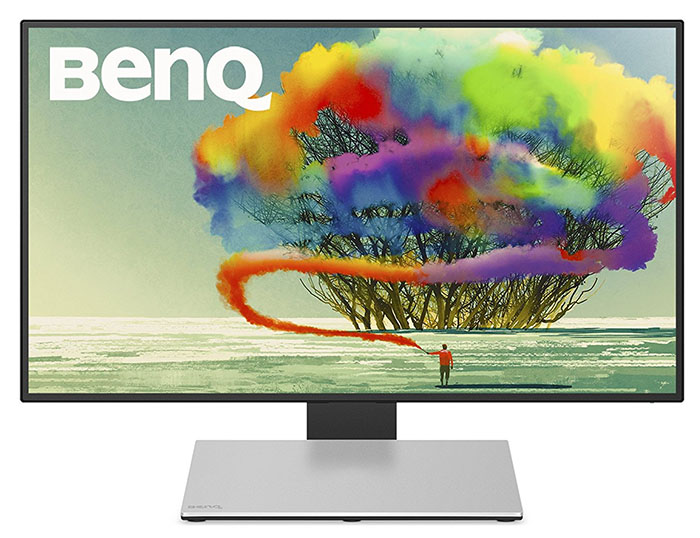

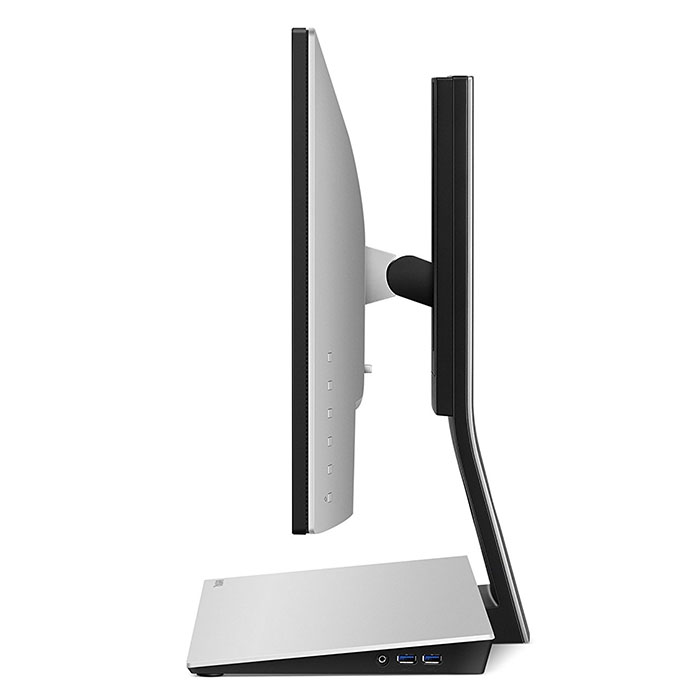
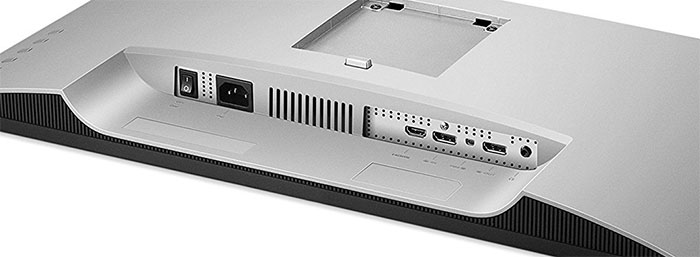
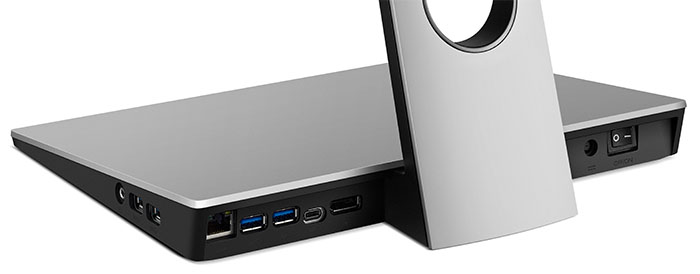
The PD2710QC is a rare BenQ monitor that isn’t all black. The chassis rear panel and the base are finished in a nice silver plastic. There aren’t any shiny bits, but the package carries off a nice contrast between dark and light. The base is all business with a large array of ports and a flat wide shape that can accommodate a closed laptop. Even a large one will fit. Our HP Spectre 360 15.6” just got its rubber feet on there.
Get Tom's Hardware's best news and in-depth reviews, straight to your inbox.
The front screen layer is the same 3H hardness used on nearly every LCD monitor today with a matte finish that rejects light well. We saw no grain or artifacts, nor was there any backlight bleed or glow in our press sample. Clarity is excellent thanks to a small air gap above the TFT layer. The bezel is extremely narrow at only 7mm and flush with the front for a seamless appearance. True frameless screens aren’t here yet but they’re getting closer all the time.
The upright is solid and well made and offers a premium feel to all its adjustments. There is no swivel, but you get 7.5” of height, 25° back tilt, and a portrait mode. If you prefer a monitor arm or wall mount, there are 100mm VESA holes under the upright’s attachment plate, which comes off at the press of a button.
The side profile is a tad slimmer than most, but no great effort has been expended to make the PD2710QC super thin. The panel’s back tapers smoothly from side to side and is only broken up by the upright mount and a cut-out for the input panel.
To use the docking station, connect its power supply brick and run a DisplayPort cable between its output and one of the panel’s inputs. If you want networking, connect a cable from your router to the Ethernet port. With a keyboard and mouse added to the station, all that’s left is to run a USB-C wire from your laptop. Everything you need comes in the box.
The base includes four USB ports plus a single USB-C input along with Ethernet, DisplayPort out, and a headphone jack. To use any of them, you must plug in the power supply. You can switch the docking station off with a toggle when you’re not using it. The panel’s inputs include two DisplayPort 1.2 (one mini), one DisplayPort output, an HDMI input, and a second headphone jack. There are no built-in speakers.
MORE: Best Gaming Monitors
MORE: Best Professional Monitors
MORE: How We Test Monitors
MORE: How To Choose A Monitor
MORE: All Monitor Content

Christian Eberle is a Contributing Editor for Tom's Hardware US. He's a veteran reviewer of A/V equipment, specializing in monitors. Christian began his obsession with tech when he built his first PC in 1991, a 286 running DOS 3.0 at a blazing 12MHz. In 2006, he undertook training from the Imaging Science Foundation in video calibration and testing and thus started a passion for precise imaging that persists to this day. He is also a professional musician with a degree from the New England Conservatory as a classical bassoonist which he used to good effect as a performer with the West Point Army Band from 1987 to 2013. He enjoys watching movies and listening to high-end audio in his custom-built home theater and can be seen riding trails near his home on a race-ready ICE VTX recumbent trike. Christian enjoys the endless summer in Florida where he lives with his wife and Chihuahua and plays with orchestras around the state.
-
kookykrazee Stop the autoplay videos from Fritz 'annoying' Nelson. THEY DO NOT NEED TO AUTOPLAY ON EVERY SINGLE AD, BLOG, AND ARTICLE YOU POST, they do not!Reply -
milkod2001 May be decent monitor but should have been $399 at most. They keep producing overpriced crap and wonder why sales are going down....Reply -
237841209 Meh, wouldn't call it "designer". Especially considering it doesn't use OLED. It would be cool if the base was a some sort of touch pad.Reply -
jholickysr Their site doesn't even list the warranty period. (Costco Canada has it already and lists it as 1yr but typically wrong information)Reply
https://www.benq.com/en/monitor/designer/pd2710qc/specifications.html
I too concur with the first post - Fritz's video has been popping up for how long now? Weeks? -
mrmez Reply20254611 said:60hz needs to die.
1440 needs to die too for non gaming screens. I've been using 5K for 3 years now.
20255012 said:Meh, wouldn't call it "designer". Especially considering it doesn't use OLED. It would be cool if the base was a some sort of touch pad.
OLED does have some drawbacks. Pixel colour fades over time, and since OLED can completely turn off pixels not in use (unlike LCD), different colours fade at different rates, leading to a growing colour imbalance over time. It's getting better of course, especially on high end displays, but still not ready for lower end. -
FritzEiv Reply20254578 said:Stop the autoplay videos from Fritz 'annoying' Nelson. THEY DO NOT NEED TO AUTOPLAY ON EVERY SINGLE AD, BLOG, AND ARTICLE YOU POST, they do not!
I will (and I do) pass along the comments on the video player. These players are a part of many sites these days, as I am sure you know. Further, I do agree with the Fritz 'annoying' Nelson part. Even *I* am annoyed with me. Every week I do ask that we change out what is played there, so that at least you get some variety. As we start to do more and more videos (and we have a few new ones coming), maybe you will have better things to look at each week, and eventually each day . . . (By the way, the ultimate idea here is that we'd have enough video whereby whatever article you are on, the video that we play is at least topically related.) Finally, the >audio< should never play out loud. I've found that it sometimes, on rare occasion, does, and I report it immediately to our ad team, because usually it's the pre-roll ad that is the culprit. -
mrmez Just being honest here...Reply
I ended up turning on my ad blocker for Tom's specifically because of those videos.
Regardless of how great or entertaining, everything gets annoying with enough repetition, and if the average user is anything like me, reading/skimming up to a dozen articles in just a few minutes... well you get the idea. The same video playing automatically every time I open a new article is enough to exceed most people's tolerance and block every ad as a result.
Like me right now, a lot of people slack off at work and read this site. I can get away with it (because I own the business) and because it KIND OF looks productive. As soon as there's a video that goes out the window. I'd scroll past it, block it, or simply stay off the site, either way I wouldn't be watching it.
